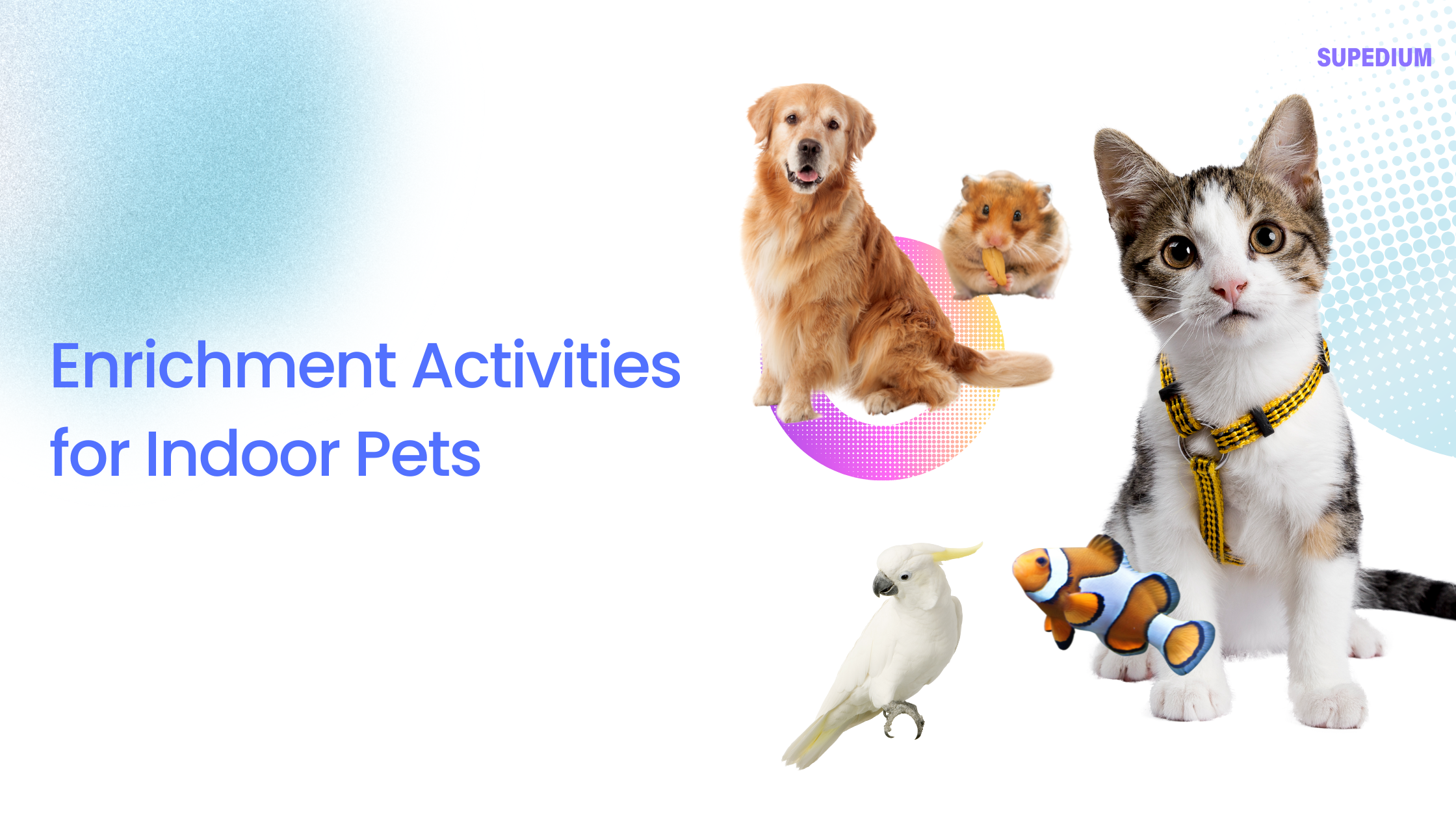Table of Contents
![]()
Introduction
Enrichment refers to a range of activities and modifications designed to enhance the quality of life for animals, particularly those in captivity. For indoor pets, enrichment is crucial as it helps to mimic natural behaviors, stimulate their senses, and prevent boredom. Without adequate stimulation, indoor pets can experience stress, develop behavioral issues, and even suffer from health problems. Understanding and implementing enrichment activities is key to ensuring that pets lead happy, healthy lives.
Benefits of Enrichment Activities
Enrichment activities offer several significant benefits for indoor pets:
- Mental Stimulation: Enrichment helps alleviate boredom and stress by keeping pets mentally engaged. It can prevent the development of destructive behaviors and encourage natural instincts, such as foraging or problem-solving.
- Physical Health: Engaging pets in physical activities helps maintain their fitness levels. Regular exercise through enrichment activities can prevent obesity and related health issues, contributing to overall well-being.
- Emotional Well-being: Enrichment activities enhance pets’ emotional health by reducing anxiety and stress. They also help to strengthen the bond between pets and their owners, leading to a more harmonious household.
Enrichment Activities by Pet Type
Cats
- Toys and Games
- Interactive Toys: Toys like laser pointers and feather wands engage cats in active play, stimulating their hunting instincts and providing physical exercise.
- Puzzle Feeders: These toys challenge cats to work for their food, which mimics natural foraging behaviors and keeps them mentally stimulated.
- Environmental Enrichment
- Cat Trees and Scratching Posts: Cat trees provide vertical space for climbing and scratching, which are natural behaviors for cats. Scratching posts help maintain their claws and prevent them from scratching furniture.
- Window Perches and Climbing Shelves: These additions offer cats a vantage point to observe the outside world, which can be particularly engaging for indoor cats.
- Sensory Stimulation
- Catnip and Scents: Catnip can induce playful behavior and excitement in many cats. Other scents, such as herbs or pheromone diffusers, can also stimulate their senses.
- Audio Stimulation: Playing recordings of bird calls or other animal sounds can engage a cat’s auditory senses and mimic their natural hunting environment.
Dogs
- Toys and Games
- Puzzle Toys and Treat-Dispensing Toys: These toys challenge dogs to solve problems to access treats, offering both mental and physical stimulation.
- Tug-of-War and Fetch: Engaging in games like tug-of-war and fetch provides dogs with physical exercise and strengthens the bond between pet and owner.
- Training and Tricks
- Obedience Training and Agility Courses: Training sessions and agility courses keep dogs mentally stimulated and physically active. They also reinforce good behavior and build confidence.
- Learning New Tricks: Teaching dogs new commands or tricks provides mental stimulation and helps to maintain their focus and attention.
- Social Interaction
- Playdates with Other Dogs: Arranging playdates with other dogs provides social interaction and helps dogs develop good social skills.
- Interactive Games with the Owner: Spending quality time playing with your dog fosters a strong bond and keeps them engaged.
Small Mammals (e.g., Hamsters, Guinea Pigs, Rabbits)
- Toys and Enclosures
- Chew Toys and Tunnels: Small mammals need to chew to keep their teeth healthy, and tunnels provide a space for exploration and exercise.
- Exercise Wheels and Play Pens: Exercise wheels offer physical activity, while play pens provide a safe space for running and playing.
- Foraging Activities
- Hiding Food in Toys or Bedding: Hiding food encourages natural foraging behavior, which stimulates mental and physical activity.
- Scatter Feeding and Treat Trails: Distributing food around their enclosure or creating treat trails helps mimic natural searching behaviors.
- Social and Physical Interaction
- Handling and Supervised Playtime: Regular handling and supervised playtime allow small mammals to interact with their environment and their owners, promoting social bonding.
- Safe Spaces for Burrowing and Exploration: Providing areas where small mammals can dig or burrow satisfies their natural instincts and provides physical exercise.
Birds
- Toys and Activities
- Foraging Toys and Puzzle Feeders: These toys stimulate birds’ natural foraging instincts and provide mental stimulation.
- Swings, Mirrors, and Bells: These items offer physical exercise and visual stimulation, keeping birds entertained.
- Environmental Enrichment
- Perches of Different Textures and Sizes: Varied perches help to keep birds’ feet healthy and offer opportunities for climbing and exploration.
- Bird-Safe Plants and Branches: Adding safe plants and branches to their environment provides additional stimulation and mimics their natural habitat.
- Social Interaction
- Training and Talking to the Bird: Training sessions and verbal interaction help to build a strong bond and keep birds mentally engaged.
- Playtime with Bird-Safe Toys: Interactive play with toys helps to provide physical exercise and mental stimulation.
Reptiles (e.g., Lizards, Turtles, Snakes)
- Habitat Enrichment
- Varied Substrates and Hiding Spots: Different substrates and hiding spots mimic natural environments and allow reptiles to exhibit natural behaviors.
- Climbing Structures and Water Features: Providing climbing structures for arboreal species and water features for aquatic species supports their physical and behavioral needs.
- Feeding Enrichment
- Live or Moving Prey: Offering live or moving prey stimulates hunting instincts and provides mental and physical exercise.
- Variability in Diet: Providing a varied diet helps mimic natural foraging and ensures balanced nutrition.
- Environmental Stimulation
- Temperature and Light Changes: Simulating natural day-night cycles and temperature fluctuations supports reptiles’ natural behaviors and biological rhythms.
- Safe Exposure to Different Textures and Scents: Introducing new textures and scents can stimulate exploration and mental engagement.
Implementing Enrichment Activities
- Safety Considerations
- Choosing Safe Toys and Materials: Ensure that toys and materials are safe and appropriate for your pet to prevent choking hazards or injuries.
- Supervising Interactions and Activities: Always supervise your pet during new activities or with new toys to ensure they are safe and suitable.
- Customization and Adaptation
- Tailoring Activities to the Pet’s Personality and Preferences: Consider your pet’s individual preferences and needs when selecting enrichment activities.
- Adjusting Activities Based on Age, Health, and Activity Level: Modify activities to suit your pet’s age, health condition, and energy levels.
- Monitoring and Evaluation
- Observing Pet’s Reactions and Adjusting Accordingly: Pay attention to how your pet reacts to different activities and make adjustments as needed to keep them engaged and happy.
- Seeking Advice from Veterinarians or Pet Behaviorists: Consult with professionals if you need guidance on suitable enrichment activities or if your pet exhibits behavioral issues.
Conclusion
Enrichment activities are essential for maintaining the mental, physical, and emotional well-being of indoor pets. By providing a variety of stimulating and engaging activities, pet owners can ensure their pets lead fulfilling and happy lives. Starting with simple enrichment activities and gradually introducing new ones can keep pets engaged and healthy. Creativity and ongoing adaptation of enrichment activities are key to meeting the evolving needs of your indoor pets.
Share This





Be the first to comment